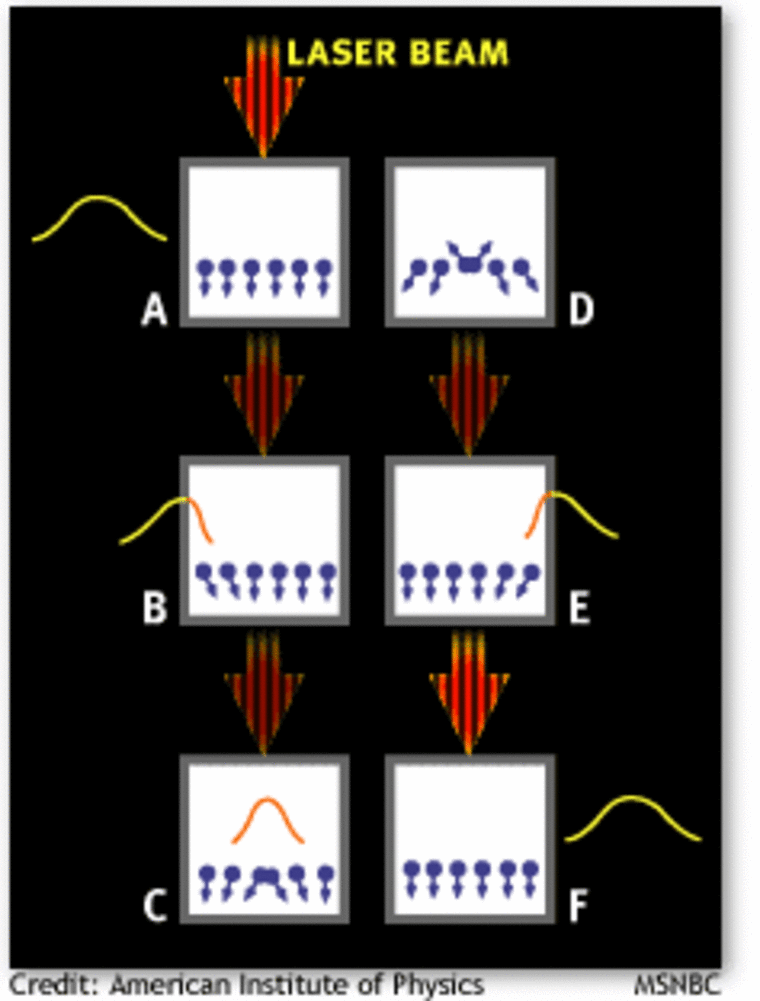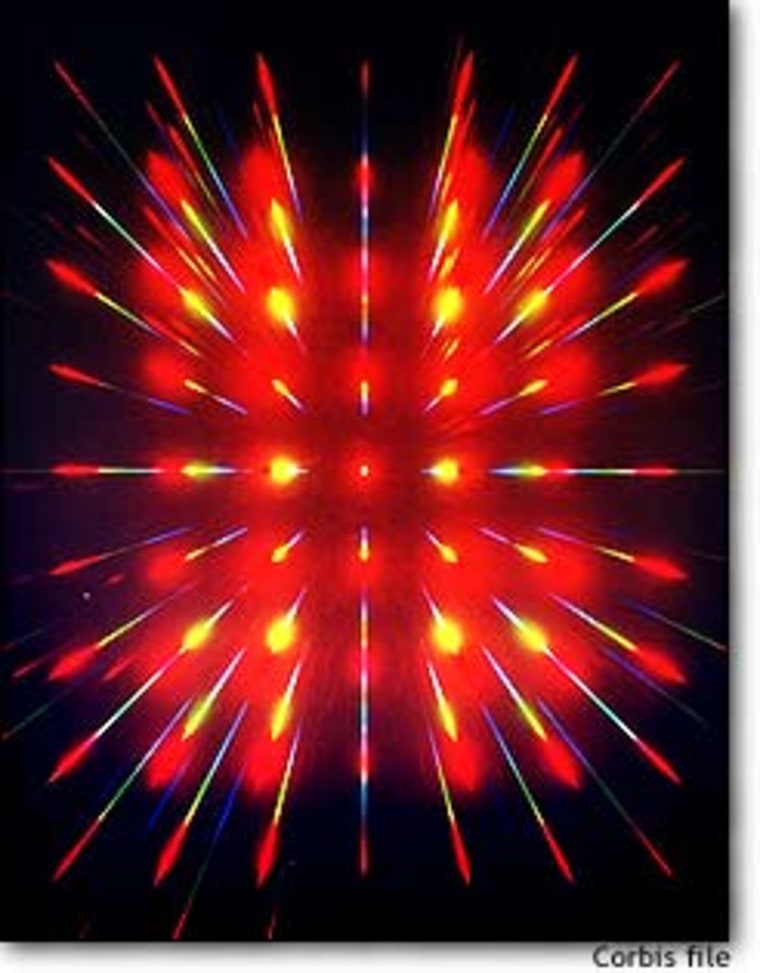Physicists say they can effectively catch a light pulse in a bottle, hold onto it and release it, in an operation described as slowing light to a dead stop. It’s actually the information about the light wave that’s being captured, the researchers say, and such techniques could be applied to a future generation of quantum computers and ultrasecure communication devices.
Light normally moves through a vacuum at about 186,000 miles per second. Nothing in the universe moves faster, and Albert Einstein theorized that nothing ever could. (Click here for some caveats.)
However, light waves can slow down as they pass through a medium. Last year, a research team at the Rowland Institute for Science and Harvard University, headed by Danish physicist Lene Hau, brought light waves down to a 1 mph crawl by putting them through a specially prepared haze of ultracold sodium atoms.
Now the same group and another team at the Harvard-Smithsonian Center for Astrophysics, led by Ronald Walsworth and Mikhail Lukin, say they have “stored” pulses of light in separate experiments.
The Harvard-Smithsonian results are being published in the Jan. 29 issue of Physical Review Letters. The Rowland-Harvard findings will appear in the Jan. 25 issue of Nature, which is not yet publicly available. However, the Nature research was released to the media on Thursday, due to the reports about the other study.
Spin control
Both teams accomplished what sounds like an impossible task: slowing down a light pulse so much that it appears to fade and stop, then starting it up again on demand. However, Lukin and a colleague, David Phillips, told MSNBC.com that the process is less crazy and more complicated than it sounds.
The experiments don’t involve stopping the actual photons, or particles of light. Instead, information about the light wave is gradually transferred to specially prepared atoms trapped within a glass chamber, and then turned back into a replica of the original light wave. That’s the real trick.
The Harvard-Smithsonian team used warm atoms of rubidium gas, while the Rowland-Harvard researchers used the chilled haze of sodium atoms that worked so well in their previous experiments.

“The details of the experiments are very different,” Phillips said. “They’re not competitive, they’re very complementary experiments.”
In each experiment, one laser beam excites the atoms in such a way that they can’t absorb light in a traditional sense, a process called electromagnetically induced transparency. Then another laser emits a pulse of light toward the chamber. When the pulse enters the chamber, the photons and the excited atoms are coupled into quantum systems called polaritons. During this coupling, the properties of the photons are transferred to the atoms, changing or “flipping” their magnetic spin. In a sense, the atoms weigh down the photons, and that drags down the speed of the pulse.
When the pulse is fully within the haze of excited atoms, the intensity of the first laser beam is reduced to zero.
“As we decelerate, the pulse has less and less photons, and at the same time there are more and more excited spins. So when we make the light go infinitely slow ... there are no photons remaining, all of the information is in the spins,” Lukin said.
He stressed that the photons are not absorbed, as they would be under normal conditions. “The photon disappears, but when one photon disappears, one spin flips,” he said.
Hau’s team said the pulse was “frozen” — essentially stored as a quantum pattern imprinted upon the atoms.
In each experiment, the information about the light pulse can be stored for about a thousandth of a second before it starts to decay. When the control laser beam is turned back on, photons are once again introduced into the system. The light pulse starts speeding up again, reaching its original velocity by the time it leaves the chamber.
“Essentially what we get is an exact replica, in the ideal case,” Lukin said.
Quantum application
Both groups said their findings could be applied to a weird technological frontier known as quantum computing.
“What’s a big deal is that you really stored this information, and that might have implications for quantum computation and quantum communication,” Lukin said.
In fact, the real value of the technique could come from “turning it inside out,” Phillips said.
“Instead of starting with a light pulse, you might imagine starting with atoms in a quantum state, and extracting the light pulse to another set of atoms, perhaps only a few inches away or maybe a thousand miles away,” he said. “Hence we will write the quantum state from the original atoms to this new set of atoms, and transmit the quantum information.”
Scientists say quantum computing could solve mathematical problems beyond the capability of existing computers, particularly involving code-making and code-breaking. And since quantum information is extremely sensitive to eavesdropping, quantum-based communication systems could provide a new level of data security.
One of the pioneers in quantum computing, IBM researcher Charles Bennett, said the efforts to slow down light represented an exciting field of research. The key, he said, is to keep the information in a quantum system free from decay, known in quantum circles as decoherence.
“If you could stop (a light pulse) and also stop the loss or at least reduce the loss of coherence, then that would be good,” he said.
But Bennett said he could not yet judge how these particular light-stopping experiments would affect his field.
In a commentary written for Nature, University of Colorado physicist Eric Cornell compared the experiments to a grand trick in which the magician makes a speeding train suddenly disappear into a sheet of gossamer fabric — and then, seconds later, just as suddenly roar out the other side.
Cornell said it wasn’t yet clear whether the experiments would truly have technological relevance to the quest for quantum computing.
“But for now it hardly matters — trainspotting doesn’t get any more interesting than this,” he said.
